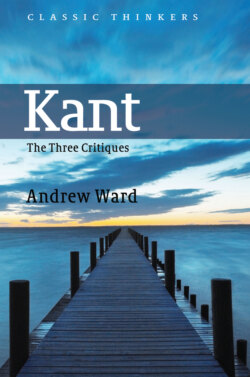Читать книгу Kant - Andrew Ward - Страница 11
Hume’s scepticism about causation and Kant’s Copernican revolution
ОглавлениеIn order to illustrate how the Kantian Copernican revolution bears on central issues in philosophy, let us return to Hume’s scepticism about causation. Hume – at least as Kant reads him – sees nothing inconceivable in the behaviour of objects in the spatio-temporal world always having been, or suddenly becoming, totally chaotic. Since a state of lawlessness in nature implies no contradiction, it is by Hume’s lights entirely conceivable. Moreover, although chaos in nature would obviously preclude us from connecting together objects, or their states, according to universal or necessary laws, Hume allows – again as Kant reads him – that we should still be able to experience objects and their changing states.
Now although this scepticism is diametrically opposed to the position that Kant adopts as a result of his Copernican revolution, there is a sense in which he accepts it. He accepts that if the traditional picture of the relationship between objects in the spatio-temporal world and ourselves is correct, then Hume’s story of a nature in chaos cannot be dismissed. But now consider Kant’s alternative, revolutionary picture. In particular, consider his claim that the laws by which the objects of nature can alone be experienced derive from certain fundamental concepts in us. If one of these fundamental concepts is the concept of cause, and the corresponding law is the causal principle (viz. every change of state must have a cause), then it would follow that we can only experience a change of state in so far as it is subject to causal law. Remarkable though such a conclusion would be if it could be shown, it can hardly be said fully to meet Hume’s scepticism. Even granting that we cannot experience a nature which is non-causal in respect of any change of state, that would seem to put constraints only on our ability to perceive such a spatio-temporal world. But Hume’s scepticism chiefly concerns the conceivability of a non-causal nature, not our capacity or incapacity to experience it.At this point, we need to bring in the other part of the Kantian Copernican revolution: that space and time are merely properties of our mind, and hence, that everything appearing therein must in reality be mind-dependent. If the objects of our senses (the objects in space and time) are, in reality, mind-dependent, then any condition on our being conscious of, and so of our experiencing, these objects must equally be a condition on the possible objects of our experience. For example, if we cannot think, and so experience, a change in the objects of our senses, except under the condition that the data apprehended by us be subject to the law of causality, then it follows – given the mind-dependency of this data – that there can be no acausal change in spatio-temporal objects. If everything that can appear in space and/or time is mind-dependent, then any restriction on our ability to experience spatio-temporal objects must equally be a restriction on the possible objects that can exist in space and time.
In sum, Kant accuses Hume of putting the cart before the horse. As Kant sees it, Hume assumes that spatio-temporal objects exist independently of our possible experience. On this traditional picture, it has to be admitted that we cannot see why these objects must conform to any of the concepts that may exist in us for connecting together the given sensuous data under laws. In particular, therefore, it is impossible to see why spatio-temporal objects must, in respect of their changes, be subject to the law of causality. On the other hand, if Kant’s Copernican picture is correct, it would have the following consequences. First, we can have no experience of spatio-temporal objects changing their states except in so far as the apprehended manifold can be thought by us as subject to the law of causality. Second, all these changing objects are dependent for their existence on our capacity to think the given manifold by means of that law. Accordingly, not only must Hume have been wrong to suppose that we might be able to experience spatio-temporal objects changing randomly; more significantly, he must have been wrong to hold that there could exist any acausal changes in these objects.
Before turning to the second stage of Kant’s Copernican project, I must stress that in this introduction I am aiming only to provide an overview of some of the main themes of the First Critique.In particular, what I have attempted in the last few paragraphs is nothing more than an outline of the strategy by which Kant hopes to answer Hume. Clearly, it is one thing to outline a strategy and another thing to show how it can be filled in to provide a convincing reply to scepticism. Most conspicuously, there are two issues that need to be addressed. First, we need to understand why space and time are held to have a mind-dependent status. Second, we need to understand why our capacity to have any experience of objects requires that the data apprehended through the senses must be subject to laws that derive from concepts existing in our mind. Without a proper appreciation of Kant’s responses to these issues, there is simply insufficient detail to decide whether he has given a plausible, let alone a correct, response to Hume. In fact, both issues are discussed at length in the First Critique. Kant’s treatment of them forms the backbone of his Copernican project.
